Working together to keep children connected
 Sue is a senior social worker in Norfolk fostering service and sits on the adoption panel.
Sue is a senior social worker in Norfolk fostering service and sits on the adoption panel.
When I heard about the University of East Anglia’s (UEA) research on transitions from foster care to adoption, I wanted to be a part of it. I got in touch with Dr Mary Beek and Professor Gillian Schofield, and our service was accepted onto the study. Along with our foster carers, we were invited to contribute our knowledge and experience. This meant bringing in our adoption service and other teams across the service.
The project aims to have all social workers, foster carers and adopters starting with the same expectations of ongoing contact and using the same language around transitions. They created really useful leaflets and literature to support this, and while every plan is different because it is based on the child’s needs, there are a set of principles that everyone around the child signs up to, which underpin the transition plan. We now use a ‘bridging’ model for transitions that aims to make moves as smooth as possible for children, acknowledges the distress of the child, whether this is explicit or not, promotes a narrative around it, and supports the emotions of the adults involved.
Moves from foster care to adoption can be challenging and everyone’s emotions can be high. Adopters have often been on an extremely difficult journey to get to this point and foster carers commonly have a strong attachment to the child leaving them. It is really important that despite the pressure on all involved, the bridge remains child-centered.
We focus on building a relationship between the foster carers and adopters before the bridging even begins. This is the most important thing we can do to make sure the young person has the opportunity to maintain their relationship with their former foster carer. A good relationship from the start also means the foster carer is well placed to provide support to the adopters, particularly in the difficult early stages and may then be viewed as part of the adopters support network.
In Norfolk, we want to enable foster carers to offer this support.
We provide emotional support, but also offer up to two weeks of payments after the child moves. This money gives foster carers the freedom to visit and support the new family without taking on a new placement straight away or can be used to cover travel costs for visits or phone calls over an agreed period and recognises the time they are providing. Financially supporting foster carers is one of the ways we show that we value the support they give their former fostered children. It has also helped us to move to an expectation that foster carers will stay in contact with their former fostered children, be that visits, calls or birthday and Christmas cards.
I have seen how this can benefit a child when it is done well. Former foster carers can often give young people a link to their past through memory books and stories from when they were younger. This can have a positive impact on a young person’s sense of identity and a greater understanding of where they have come from and how important they are to the adults who have cared for them.
There is still a lot to do though. For a child a move is a move, whether they are going to an adopter, a new foster placement, an SGO or to birth family. The disruption to their relationships may still be significant and confusing, particularly for pre-verbal children. We are working to make sure that whenever a child moves within or out of the care system, keeping connected is a priority and the child is always at the heart of it.
The Fostering Network is calling on all fostering services and local authorities to sign up to our Keep Connected principles. Find out more about the campaign.





